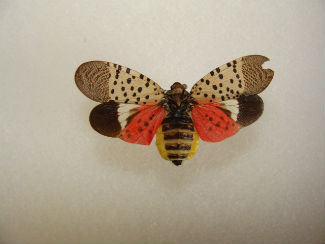
Virginians may not need to worry about murder hornets, but they should be on the lookout for another invasive pest—the spotted lanternfly.
First seen in Virginia in 2018, the pest is a threat to 70 ornamental plants, trees and various crops, including apples, grapes, hops and stone fruits.
Once limited to Winchester and Frederick County, the pest is quickly expanding its territory despite vigorous prevention measures. Adult spotted lanternflies were found in Clarke County last fall.
“This thing has an exponential spread,” said Eric Day, manager of the Virginia Tech Insect Identification Lab. “We went from one square mile in January 2018 to 60 square miles in June 2020.”
During this time of year, eggs have hatched and nymphs feed on plants in droves. They extract sap with a mouthpiece that acts like a straw and taps into the plant, leaving behind a hole that can cause sap leakage and attract more pests. Lanternflies also secrete honeydew, a sugar-rich liquid waste that can serve as a medium for mold and fungal growth, further stressing and damaging plants.
While experts report the bugs are primarily a problem in residential backyards right now, they’re dreading the day the pests show up in vineyards or orchards.
“We anticipate as the infestation area in Virginia expands, grapes will be the most impacted,” said Mark Sutphin, a Virginia Cooperative Extension agent in Frederick County.
The spotted lanternfly also is having an adverse effect on Virginia’s shipping and commerce. It hitches rides on items being transported and lays eggs on plants, lumber, firewood, construction materials, equipment and vehicles. A quarantine is in place for Frederick County and the city of Winchester.
“Human-aided movement is the greatest risk,” Sutphin said. “If an egg mass is moved by human activities, you have the possibility to start a new population. This insect could honestly show up anywhere.”
Under the quarantine, businesses must obtain a permit from the Virginia Department of Agriculture and Consumer Services and inspect articles considered a risk for transporting the spotted lanternfly before moving them out of the area.
“Everyone in and around the quarantine zone can help control its spread by checking their property and vehicles for egg masses, nymphs and adults and then reporting their presence,” said Tony Banks, senior assistant director of agriculture, development and innovation for Virginia Farm Bureau Federation. “It can be controlled by removing egg masses and using approved insecticides.”
Report sightings by calling 804-786-3515 or emailing [email protected]. For more information on the spotted lanternfly, quarantine area and prevention measures, visit bit.ly/3fQWDGV.










